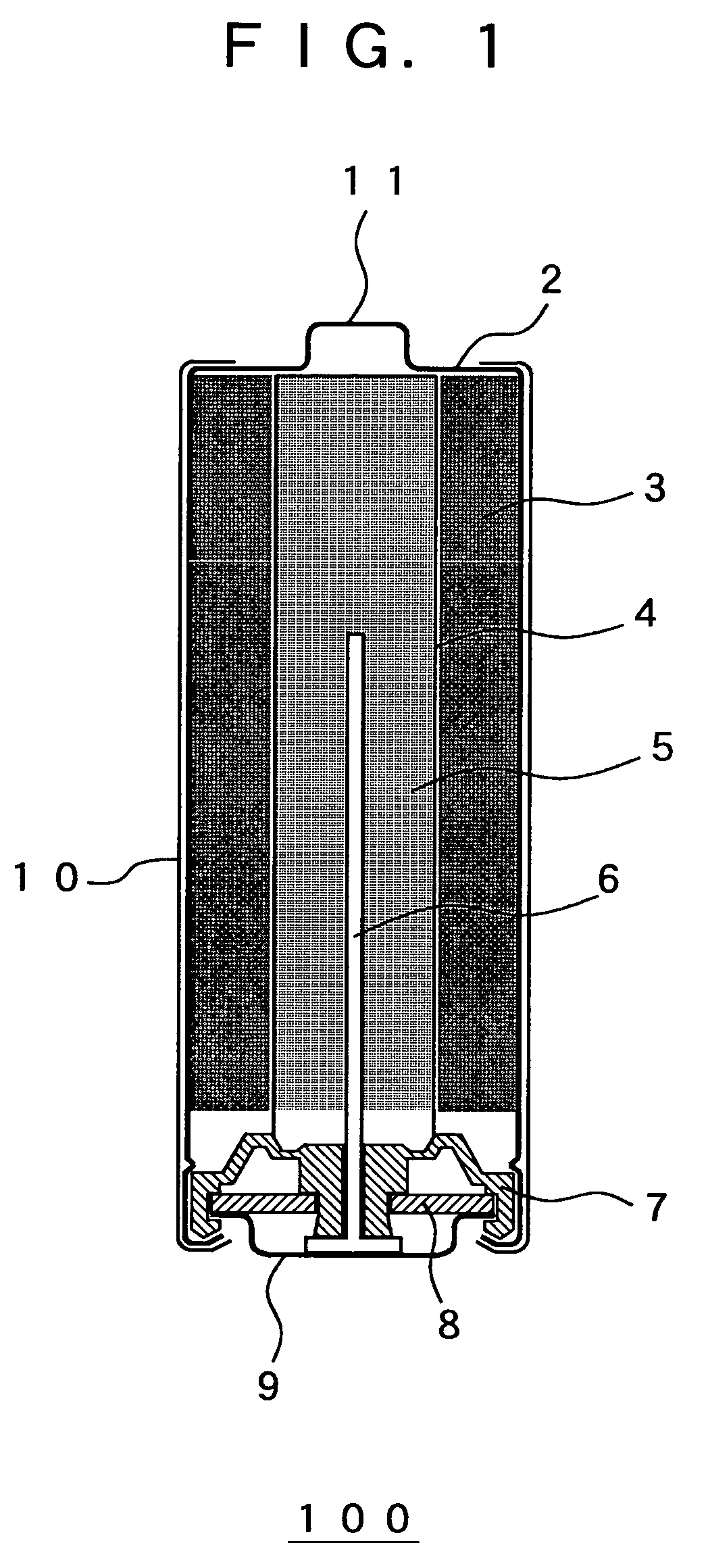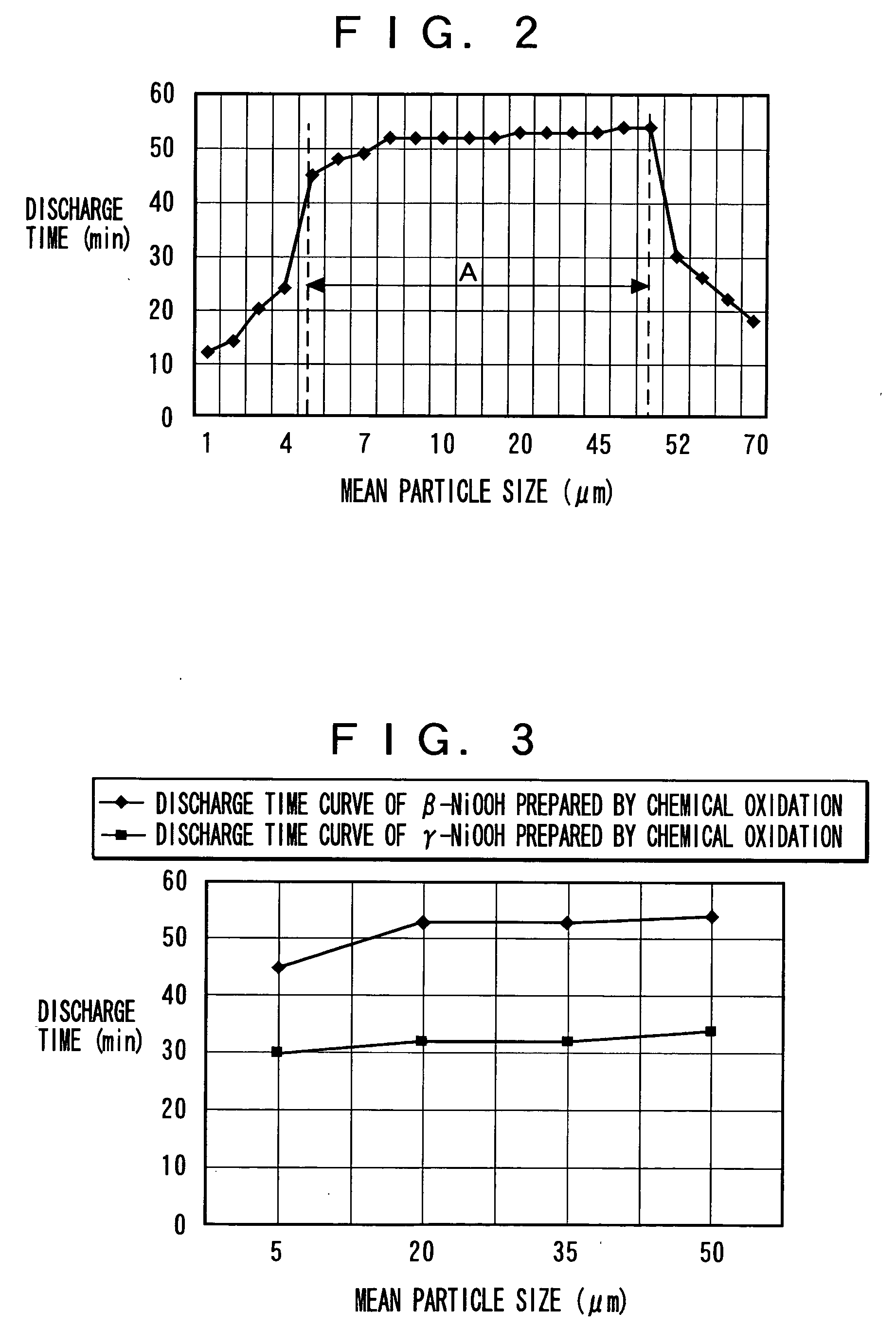Alkaline battery
- Summary
- Abstract
- Description
- Claims
- Application Information
AI Technical Summary
Benefits of technology
Problems solved by technology
Method used
Image
Examples
second embodiment
the present invention will be described hereinafter.
The configuration of the alkaline battery in the second embodiment is the same as the configuration of the alkaline battery 100 in the first embodiment (see FIG. 1).
The alkaline batteries in Examples 1 to 13 in the second embodiment are described below.
The alkaline batteries in Examples 1 to 13 were produced according to the above manufacturing procedure of the alkaline battery 100 using β-nickel oxy-hydroxide prepared by chemical oxidation for the cathode mix 3 with its particles having approximately spherical shape and cumulative pore volume in connection with pore sizes of not larger than 0.5 μm in the particles thereof being changed in the range of 5 to 70 μl / g.
Characteristics of the alkaline batteries in Examples 1 to 13 were evaluated under two test conditions. In condition 1, the discharge time was measured until the discharge termination voltage reaches 1.0 V with a constant discharge power of 1.5 W at the ambient te...
third embodiment
the present invention will be described hereinafter.
The configuration of the alkaline battery in the third embodiment is the same as the configuration of the alkaline battery 100 in the first embodiment (see FIG. 1).
The alkaline batteries in Examples 1 to 16 in the third embodiment will be described below.
In Exarmples 1 to 16 of this embodiment, the batteries were respectively produced according to the same production procedure of the alkaline battery 100 described above using, as β-nickel oxy-hydroxide to be used in cathode mix 3, β-nickel oxy-hydroxide produced by chemical oxidation and having an approximately spherical shape of particle, with content of sulfuric acid radical contained in the β-nickel oxy-hydroxide altering from 0.005 to 0.7% by weight.
Characteristics of these alkaline batteries were evaluated under four test conditions. In condition 1, the discharge time until reaching a discharge termination voltage of 1.0 V was measured after the production of the batter...
fourth embodiment
the present invention will be described hereinafter.
The configuration of the alkaline battery in the fourth embodiment is the same as configuration of the alkaline battery 100 in the first embodiment (see FIG. 1).
The alkaline batteries in Examples 1 to 4 in the fourth embodiment and Comparative Examples 1 and 2 were investigated.
A battery can 2 of LR6 (AA) size made of a nickel-plated iron plate on the surface was used in Example 1. Organic paint containing graphite powder and binder was sprayed and dried on the inner surface of the battery can 2 to form a conductive paint film.
As cathode mix 3, β-nickel oxy-hydroxide prepared by chemical oxidation and having approximately spherical shape of particle and graphite powder were mixed in a dry state in a proportion of 10:1 and PTFE was then mixed to the mixture of the β-nickel oxy-hydroxide and the graphite powder in an amount of 0.1% by weight followed by adding to it a 40% by weight potassium hydroxide solution in an amount of ...
PUM
 Login to View More
Login to View More Abstract
Description
Claims
Application Information
 Login to View More
Login to View More - R&D
- Intellectual Property
- Life Sciences
- Materials
- Tech Scout
- Unparalleled Data Quality
- Higher Quality Content
- 60% Fewer Hallucinations
Browse by: Latest US Patents, China's latest patents, Technical Efficacy Thesaurus, Application Domain, Technology Topic, Popular Technical Reports.
© 2025 PatSnap. All rights reserved.Legal|Privacy policy|Modern Slavery Act Transparency Statement|Sitemap|About US| Contact US: help@patsnap.com



